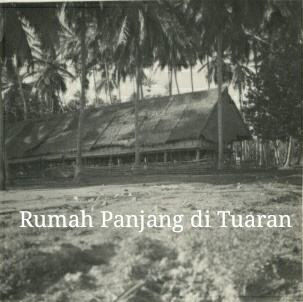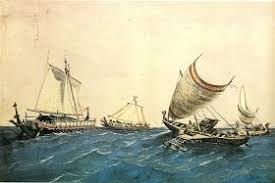LEGEND OF "WATU PAPAKANG"
- Marwan Bin Musa
- Feb 26
- 3 min read

"Any study of a culture that does not include folklore is incomplete, and folklore may suggest clues to past events and archaic customs" (Bascom, quoted by Sonza 1979.)
Papakang is a type of striker made from a specific kind of stone. When struck against another particular stone in a certain way, it produces a pleasant, rhythmic, and somewhat extraordinary sound. The stone striker is small at the handle, extending straight and elongated at the front from the grip. The stone being struck has a dent or curve in its center.
Long ago, there were seven siblings who grew up to become mighty and courageous warriors living in the settlement of Nunuk Ragang. One day, while swimming in the Liwagu River, they noticed a glowing object at the bottom of the river. The eldest brother immediately dived in to retrieve the glowing object but failed. The second brother also attempted but was unsuccessful. One by one, from the third to the sixth brother, they all tried and failed. Finally, the youngest sibling, with great determination and effort, succeeded in retrieving the glowing object and brought it to the river’s surface.
Upon examining the peculiar glowing stone, they discovered that it was a long stone, about the thickness of a wrist, round, smooth, black in color, and had several lines on its surface. The attraction, uniqueness, and mystery of the magical stone led the seven siblings to desire possession of it, believing it might have supernatural and extraordinary powers. The siblings quarreled and fought amongst themselves over ownership of the mysterious stone.
Their father, upon learning of their quarrel, intervened to prevent further conflict and possible disaster. To resolve the dispute, he seized the mysterious stone from one of his children and smashed it against the ground, breaking it into two. He then took another stone and struck the magical stone until it shattered into seven pieces. Gathering the seven fragments, he called his children and gave each of them one piece, saying that if they ever separated and traveled their own paths in life, they must keep their stone as a memento.
These fragments, when reunited in the future, would serve as proof that they were from the same family lineage, bound by kinship. These mystical stones came to be known as "Watu Papakang."
With love and wisdom, their father also crafted seven large jars known as "Tagamans" and gave one to each of his children. These jars were made from a special type of clay sourced from Kampung Bitoon, Ranau.
Eventually, the seven siblings parted ways, each leading their followers in different directions—north, east, west, and south of Northern Borneo.
The names of the seven siblings were Longguwai, Runsud, Tinggoron, Lintobon, Tomui, Turumpok, and the youngest sibling’s name remains unknown.
"Aki Longguwai" was the first among the siblings to leave Nunuk Ragang, according to the Rungus and Tibabar legends. The Sukang tribe claims lineage from Aki Longguwai. The Dumpas, Mangkaak, Gunatong, and Poruzou tribes are also believed to descend from Aki Longguwai.
"Aki Runsud" attempted to follow Aki Longguwai’s path but eventually settled in Kudat. The Rungus tribe believes they originated from Aki Runsud. From Aki Runsud, the Momogun, Rungus, Gonsomon, Nulu, and Pilapazan tribes emerged.
"Aki Lintobon" was the youngest among the seven siblings. The Tibabar tribe believes they descended from Aki Lintobon. The Mononggigi, Tobilung, Kimaragang, Tuhawon, Tibabar, Kolikuan, Potiukan, Tompios, Minokok, Kiruiou, Korupan, and Tasapang tribes claim lineage from Aki Lintobon.
"Aki Tomui" had a son named Dusun. The Liwogu tribe asserts that they descended from Aki Tomui and named one of their villages "Kampung Tomui." The Liwogu, Tindal, Kuijau, Bundu, Liwan, and Sinulihan tribes trace their roots to Aki Tomui.
"Aki Turumpok" was one of the siblings but mysteriously vanished after meditating in a cave.
"Aki Tinggoron" settled in the Telupid area. From his lineage, the Koroli, Kotoring, Kiwulu, Sogo, Sungangon, Dalamason, Tampulung, Songilitan, Bayok, Dusun Klias, Putih, Tindakon, and Turawid tribes emerged.
To this day, replicas of "Watu Papakang" have been made based on the original legendary "Watu Papakang" before it was divided into seven pieces.
Between 2004 and 2006, at least six "Watu Papakang" stones were preserved by villagers in the Nunuk Ragang settlement area, with some measuring up to 30 cm in length.
"Watu Papakang" was a type of stone crafted and used by the original inhabitants of Nunuk Ragang.
Each legend has its own versions, and this is one of the many versions of the "Watu Papakang" legend and the Seven Siblings of Nunuk Ragang, passed down through generations.
Sources:
Inland People of Sabah Before, During, and After Nunuk Ragang by P.S. Shim
Jiman Bin Yusup, Matupang
Gurang Bin Puah, Telupid
Editor and Writer:
Kumis Kumis







Comments